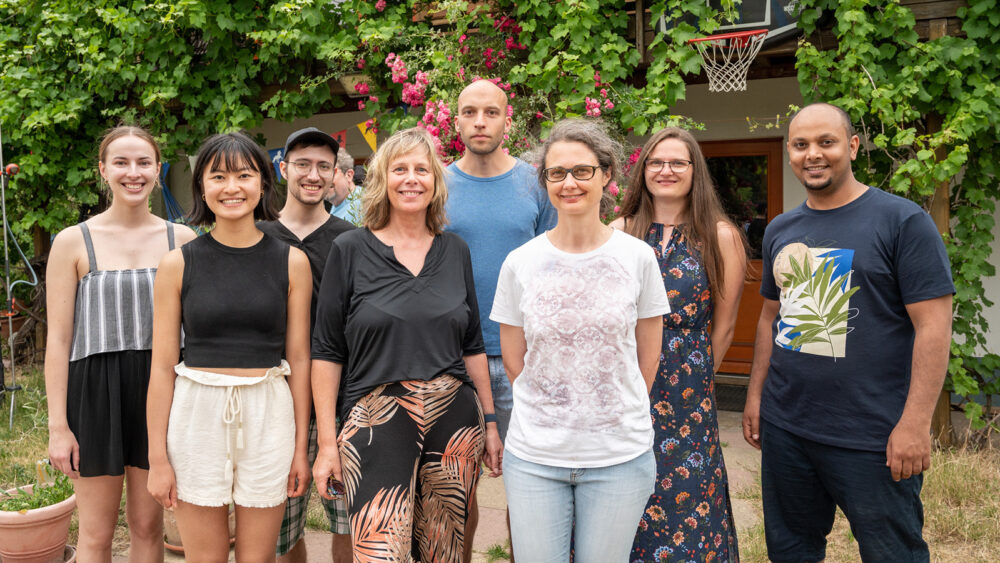

Baumgrass lab
Regulation of cytokine expression in different T cell subsets
Signal Transduction
A detailed molecular understanding of the mechanisms of T lymphocyte activation and activation-induced cell fate decisions will contribute to understanding their role in the induction and perpetuation of chronic inflammation and eventually allow a window to address them therapeutically.
To this end, we investigate the molecular regulation of cytokine co-expression, digital decision making and protein-based pattern recognition of immune cells under physiological and pathological conditions in systemic lupus erythematosus (SLE) and multiple sclerosis (MS).
Global unbiased approaches and multi-parametric visualization tools help us to decipher which cells are hyperactive in chronic inflammatory diseases (e.g. rheumatoid arthritis, SLE, MS, atopic dermatitis) and how they change during the course of the disease. For this purpose, we continuously use high-dimensional single cell protein data (cytometry data) and our newly developed tool for the analysis and visualisation of multi-parametric data “Pattern Recognition of Immune Cells (PRI)”.
Using these techniques, we have collected the first evidence with multi-parametric cytometry data (own flow and public mass cytometry data) that our bioinformatic approach PRI is useful for a comprehensive characterisation of Th cell subsets. We have also identified and characterised a novel Tfh-like subset having super-functional cytokine producing properties and can provide B-cell help in lupus nephritis mice in an IL-21- and CD40L-dependent manner. Using combinatorial cytokine expression studies of healthy controls and MS patients, we discovered certain patterns of cytokine co-production along with activating and inhibitory receptors in memory Th cell subsets. Furthermore, comprehensive interactom analysis at the foxp3-TSDR revealed a sequence-specific recruitment of the histone-methyltransferase Ehmt1 and the transcription factor WIZ in conventional T cells. Their deletion promotes foxp3 expression and thereby Treg cell induction.
Our results will help us to find further decisive switches in T cells not only to attenuate hyperreactive T cells, but also to modify them in such a way that the immune system readjusts itself. In addition, our results could also be useful for diagnostic and prognostic purposes by identifying and characterising immune cell subpopulations multi-parametrically.
Keywords
T cell activation
T cell differentiation
Transcription factors
Cytokines
Multi-parametric analysis
Combinatorial protein expression

Group leader:
Apl. Prof. Dr. rer. nat. Ria Baumgrass
Scientists
Dr. Ines Hoppe
Dr. Wail Ahmed
PhD students:
Johannes Groffmann
- Detlef Groth, Joachim Selbig, University of Potsdam, Bioinformatik, Potsdam
- Hanspeter Herzel, Fridolin Groß; Humboldt-Universität Berlin (HU), Institut für Theoretische Biologie (ITB), Berlin
- Matthias Selbach, Matthias Sommer, Max-Delbrück-Centrum für Molekulare Medizin (MDC), Proteome Dynamics, Berlin
- Johannes Schuchard; Ivo Bachmann, Microdiscovery GmbH, Berlin
- Julio Vera-Gonzalez, Friedrich-Alexander University (FAU), Laboratory of Systems Tumor Immunology, Erlangen
- Olaf Wolkenhauer, Saptarshi Bej, University of Rostock, Department of Systems Biology and Bioinformatics, Rostock
- Margitta Worm, Felix Kiecker, Charité, Dermatology, Berlin
- Friedemann Paul, Charité, Clinical Neuro-Immunology, Berlin
Karl, M., Sommer, C., Gabriel, C.H., Hecklau, K., Venzke, M., Hennig, A.F., Radbruch, A., Selbach, M., and Baumgrass, R. (2019). Recruitment of Histone Methyltransferase Ehmt1 to Foxp3 TSDR Counteracts Differentiation of Induced Regulatory T Cells. J Mol Biol 431, 3606-3625. doi: 10.1016/j.jmb.2019.07.031.
Gabriel, C.H., Gross, F., Karl, M., Stephanowitz, H., Hennig, A.F., Weber, M., Gryzik, S., Bachmann, I., Hecklau, K., Wienands, J., et al. (2016). Identification of Novel Nuclear Factor of Activated T Cell (NFAT)-associated Proteins in T Cells. J Biol Chem 291, 24172-24187. doi: 10.1074/jbc.M116.739326.
Fuhrmann, F., Lischke, T., Gross, F., Scheel, T., Bauer, L., Kalim, K.W., Radbruch, A., Herzel, H., Hutloff, A., and Baumgrass, R. (2016). Adequate immune response ensured by binary IL-2 and graded CD25 expression in a murine transfer model. Elife 5. doi: 10.7554/eLife.20616.
Fang, Z., Hecklau, K., Gross, F., Bachmann, I., Venzke, M., Karl, M., Schuchhardt, J., Radbruch, A., Herzel, H., and Baumgrass, R. (2015). Transcription factor co-occupied regions in the murine genome constitute T-helper-cell subtype-specific enhancers. Eur J Immunol 45, 3150-3157. doi: 10.1002/eji.201545713.

 Deutsch
Deutsch
